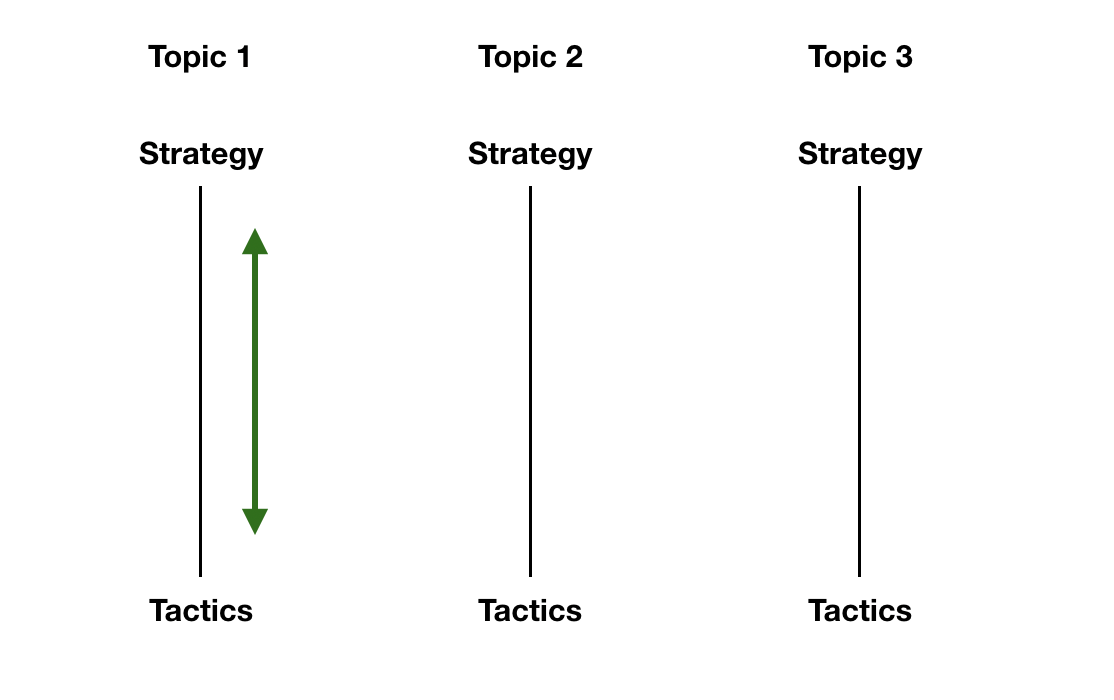5-second summary
- Research shows it can take up to 9.5 minutes to get back into a workflow after switching between digital apps.
- Nearly half of workers report that context switching is a drain on their productivity.
- Context switching may have the biggest impact when you’re switching between tasks and topics multiple times over a single day.
Ever finish a workweek in a state of total exhaustion but you weren’t sure why?
You had your usual amount of sleep. You didn’t work any extra hours. You didn’t even experience more stress than usual. But for some reason, by Friday afternoon, you’re ready to go to bed and not get up until Sunday.
One possible explanation is that your context-switching tax was too high throughout the week.
What is context-switching?
The concept of context-switching is often applied to software, but it also pertains to human productivity.
”From a human workforce perspective, context switching is the process of stopping work in one project and picking it back up after performing a different task on a different project,” explains Todd Waits on the Carnegie Mellon Software Engineering Institute blog. “Just like computing systems, human team members often incur overhead when context switching between multiple projects.”
The true cost in time and productivity
Context-switching is a proven drag on productivity. According to a joint report by Qatalog and Cornell University’s Idea Lab:
- On average, people take nine and a half minutes to get back into a productive workflow after switching between digital apps.
- 45% of people say context-switching makes them less productive.
- 43% of people say switching between tasks causes fatigue.
The fatigue factor may be rooted in the fact that our brains have limited capacity to hold information “in mind” at any given time. Consider that most knowledge workers are working with a significant amount of distractions and inputs at any given moment – hello, multiple browser tabs and chat applications and people speaking at the same time on a video call.
Hustling from meeting to meeting, topic to topic, and depth to depth can put a strain on even the most nimble mind.
Examples of how the context-switching tax adds up
Here are some observations I’ve made about how context-switching impacts my own work. See if you can relate.
Moving between strategy and tactics for a single topic is generally not that taxing, and often happens naturally as I discuss, document, or do. I’m switching tasks, but I’m focused on one broad idea.

Moving between topics but staying at the same depth of thinking or doing can start to be taxing because it requires a little context-switching. I’ve found that I can reduce the tax by reducing the number of times I switch topics.

But I manage a team, which means that I often switch topics several times a day. The more often I switch and the more topics I cover, the more taxing it becomes. However, I’ve noticed that staying at the same depth can help reduce the tax.

The hardest switch is to change topic AND depth. I’ve found that on certain days, this can be quite jarring and drain my productivity.

Once I start changing topics and depth, I notice that my context-switching tax is really climbing. After a few days of this, and I’m usually feeling serious mental fatigue.

How do I know when the context-switching tax is climbing too high? Here are a few signs:
- I miss the details when I read something and end up asking a question that was literally answered on the page or in the deck.
- When I land on a new task that I’m quite capable of completing, I have no idea where to start.
- I defer tasks that should be simple to complete, moving the “work block” for that task on my calendar multiple times.
These are the signals that I need to reset!
3 revelations from my ‘living lab’ experiment
I decided to run a little experiment on myself to see if I could mitigate the context-switching tax. The results were surprising.
Traditional suggestions include organizing the day to batch like things, saying “no” to new requests, or handing work off to someone else with more bandwidth. Those seemed reasonable, but I found that I needed to consider some more fundamental things first.
1. Batching tasks may not work for everyone
Most people identify strongly with either the concept of work-life balance or work-life integration. The former attempts to bucket time into distinct compartments, with strict separation to keep things “in balance.” The latter sees time and energy in a more continuous way, weaving in a mix of personal and professional endeavors throughout the day.
I’m more of an integrator, so it turns out that attempting to batch my day into discrete topics or depths actually caused me to feel more stressed, and at times, bored. I like moving from one thing to the next! I like having the freedom to move tasks around as I feel inspired! So traditional batching didn’t work for me. But does that mean I’m back to paying a high tax, with no recourse? Not quite.
2. It’s easier to switch thoughts than actions
I was surprised to find that switching my mindset was less disruptive than switching tasks.
For example, my role is quite collaborative and, as a manager, I spend a fair amount of time in meetings. If my primary switch is simply changing mindset from meeting to meeting, then the change in topic or depths is not as problematic.
But if I have to switch among actions, it’s much more difficult. Think of trying to write a three-year strategy document and then immediately trying to copyedit a tweet. Or architect the infrastructure for a new system and then immediately find the missing semi-colon that’s causing a system to crash. Exhausting!
3. Fitting smaller tasks into the bigger picture eases cognitive load
As I mentioned before, batching wasn’t a great solution for me. However, I found that laddering smaller actions up to a bigger project throughout the week can be extremely helpful. This allows me to make connections so I feel less impact when I’m switching topics or depths. Plus, it still gives me enough variety and freedom to make the most of my working hours.
I also try to balance my projects on a monthly basis vs. a weekly or quarterly basis. Sure, I need to do some long-term brainstorming and planning. And yes, it’s helpful to have a priority list. But for me, the monthly view is more helpful as I’m switching.
Strategies to try
Ready to run your own experiment? Here’s a few quick tricks to try for yourself:
- Bring greater visibility to your work. Some people swear by the Getting Things Done method from David Allen, which encourages practitioners to write down everything they need to do in a given period and then prioritize. Other people love a “top three things to do today” list on a sticky note. No matter how you choose to document your objectives, the key is making it visible.
- Get clear on your metrics. What does success look like for each task, each project, and each day? Understanding how you’re measuring outcomes helps you evaluate all the work you laid out in step one. It means that you can have transparent conversations with your team and stakeholders to determine which activities drive the most impact.
- Practice honest prioritization. How are you going to allocate your mental, physical, and emotional energy? All things are not equal, so be honest with yourself, your team, and your stakeholders about how you’re prioritizing work relative to your bandwidth.









































